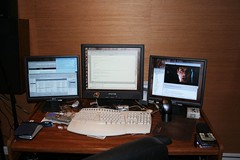 You may ask “Why?” so I’m going to tell you straight out.
You may ask “Why?” so I’m going to tell you straight out.
When I first started working at Kruse, I mentioned in my interview that I had used more than one monitor hooked to a computer. And I had.
I used my main monitor for the computer, and I hooked a Wyse terminal to my serial port. The serial port, used with vt100 output, would output debug information while I used the computer to write programs. A pretty sweet setup for the time.
Since then, I’ve had two monitors at various points. Early second monitors have been TV output from a video card that supports TV-out in addition to the main display. The resolution was always kind of lousy, but useful if I wanted to playback video while I was coding.
A month or two ago, I put a new video card in my PC, an ATI All-In-Wonder X800. This card had everything my older video card had, with one additional feature - dual head VGA/DVI output. Finally, real 2-monitor output. This was in addition to the existing All-In-Wonder support for video-in that my old card had.
I took advantage of some of the cheap, cheap prices on decent LCD monitors these days, and voila! Two-monitors on my desktop.
But the addiction to more PC desktop space was only beginning…
I recently decided that the two screens was just not enough. I needed another screen. I looked around on the net and found pretty lousy resources for information on how to make three monitors work. But here’s what I did.
I bought a new Radeon 9250 PCI card to add to my existing X800 AGP (hey, not PCI-e on my good old PC). I installed the new card, and added just the updated drivers for the card (and NOT that card’s Catalyst application, which ended up with me rolling back the system using some special softwre I have installed). With that installed, the existing Catalyst application noticed the new card, and everything worked fine.
I spent some time looking for three-screen wallpaper and a three-screen screensaver and installed those. The other truly essential software is UltraMon, which among other things, puts a task bar on each screen with just that screen’s applications, controls wallpaper and screensaver settings, and adds extra buttons to every window to easily swap them to a different screen or maximize them over all three screens. Pretty cool.
The only trouble I had was trying to use the TV application to display the TV-in from the X800. After I had the cards configured to work with their monitors, I couldn’t get the video from the satellite receiver to play into the computer. The ATI TV application kept reporting errors with the card configuration, and no matter what I tried, I couldn’t convince it that everything was ok.
So then I stumbled upon this excellent little piece of software, Chris TV. Chris TV supports the video-in on my X800, and it correctly handles the line-in on my sound card for volume control (since the sound comes in through my sound card, and not the video card, which sounds weird, and it is). It has built-in PVR features that are better than the ATI application - it’s just an all-around better app. ATI would do well to license it for distribution with their cards.
I can still only play live video on one of the two monitors hooked to the X800 where the TV-in is. I can drag the video window onto the third monitor, but the video stalls until I drag it back. I’m not sure why this is - it’s supposed to be outputting the video from a buffer, not using the overlay.
Also weird is that DVD playback only works on the two X800 screens through Windows Media Player. If I try playback on the third screen, the application complains about analog copy protection not being available there, and that it won’t play. Of course, this is all circumvented by playing back the DVD with VLC.
Finlly, I threw a Belkin Flip into the mix. The Flip is a KVM switch that allows me to hook a single Keyboard, Monitor (“V” for Video), and Mouse to more than one computer. I’ve hooked my right-most monitor to my regular desktop computer and my “server” system, an old P2-350 with Windows XP relegated to use as a file server. (Yes, yes, it could be running Linux, but being that it’s an old desktop, there is quite a bit of stuff there that I don’t want to remove just yet.)
When I push a little button on my desk, the right screen flips to the server display, and my mouse and keyboard control that PC. Push it again, and it switches back to the right monitor on my main desktop PC.
So. Is the setup more productive? I think so. I don’t find myself lookin for space to open windows like before. I tend to run a lot of programs at once when I work. I can keep things I use often open larger than before, saving a lot of dragging and resizing. I really do think it’s an improvement.
Ok, it’s a little crazy, but it looks darn impressive.